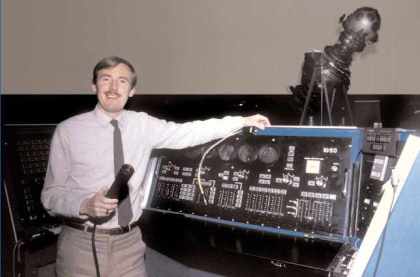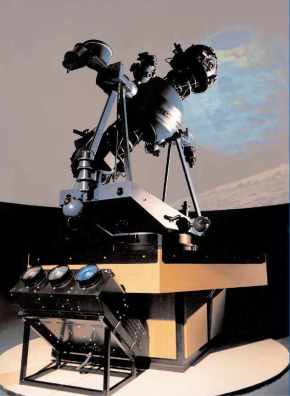Today I will look at the Fulldome industry, where it came from, and perhaps where we might be going.
I will refer to several industry resources and providers also.But first, a short history lesson, sadly leaving many innovators unmentioned out of my desire for brevity.
Planetariums have had a long history of experimenting with new technology, combining not only the star projector, but projectors that were custom made for the dome environment, as well as multiple slide projectors.
This was back in the 80’s when the term “Multi-Media” was coined, and in the corporate world it generally meant not today’s definition of presentations on a computer screen, since computers were still pretty scarce back then, but multiple slide projectors. A very wide panorama could be created with 3 slide projectors fitted with wide lenses. A soft edge on the sides smoothly blended the images together. By utilizing additional projectors a logo or other graphics could be made to float over the background. This was a very cost effective method to create presentations with a LOT of impact. Electronic system were created specifically to program and control multiple slide projectors.
Planetariums and electronic venders were quick to adopt and to innovate in this field.
Planetariums started experimenting with video projectors in the late 1980s, as soon as video projectors were available. From a single video image to a multiple projector system was quite a natural leap, but it was not without difficulty. Alignment, synchronization, brightness and contrast matching were all areas that had to be controlled, and they still can cause problems.
Innovator Terrance Murtaugh at the Armagh Planetarium and his staff were pioneers in this area, and soon flight simulator/computer graphics engineers at Evans and Sutherland and planetarium designer Steve Savage at Sky-Skan developed dome covering video presentations.
Innovator Terrance Murtaugh at the Armagh Planetarium
http://www.armaghplanet.com/pdf/historical_panels/APL_Panel_06%20V2.pdf
Soon many of the larger planetariums began utilizing video in at least part of their shows.
IMAX developed in parallel to Fulldome, and experienced film companies created many amazing shows. A robust IMAX projector and a high powered lamp created a bright and stable picture.
Video could not compete in the early days due to the minimal resolution, low brightness, and technical issues. Eventually, higher resolution and brighter images allowed multiple or even single projectors to cover a large area.
So where are we today?
Well in 1998 this is where planetarium Director Jim Manning THOUGHT we would be!
Not too far off, Mr. Manning!
Currently multiple venders are selling Fulldome systems, often using off the shelf equipment. Entertainment venues are popping up that utilize this technology.
Though still primarily seen in museums and planetariums, the immersive dome environment is being recognized as an amazing place to experience something.
The Giant Screen Association, formerly concerned only with film, has become very interested in Fulldome and is looking at one of its major drawbacks: the lack of standards.
The GSCA is currently working on that issue, just as had both IMERSA and the International Planetarium Association.
Mark Peterson of Loch Ness Productions has created an excellent summery he calls The 2012 State of the Dome Address.
This is an excellent survey of where we are now by an experienced individual.
http://www.lochnessproductions.com/reference/2012state/2012stateofthedome.html
To summarize his summery – a risky proposition but one I will tackle none the less – each year around 52 million people see a show inside a dome.
However Mark’s totals are vague if not impossible to verify as more and more home made systems and portable domes are utilized. I’d suggest (rather obviously) that number is valid only for the reporting institutions.
Dropping prices on video projectors, new venders, the “maker” phenomenon that inspires technically capable and creative types to build their own domes and projection systems will continue to add to the uncounted numbers.
The vast majority of presentations are astronomically oriented. This is quite understandable given that most are in planetariums! But even planetaria are known to branch into other topics.
Cultural presentations, entertainment, and scientific visualizations of MANY kinds are also being created.
Video producers from other genres are introduced regularly at venues such a SIGGRAPH where Sky-Skan has set up a dome for many years. Domefest by David Beining is an amazing event and the show reel travels to other locations regularly. We presented the majority of the 2013 domefest reel here recently. For a complete list I will refer you to the links section at the end of this document.
We recently screened the finals for the SDSU film composition class of Dr. Joeseph Waters. In 2014 we will screen material from UCSD computer graphic students.
It was suggested that there might be a collaboration between the SDSU music students who had to search for full dome materials to compose their music to, and the UCSD students who are creating original videos.
This is an exciting period, an on-going time of creative and technical flux. While the Fleet was the proud owners of the second IMAX projector ever built and the first tilted dome for 40 years, we can no longer count on operating the same equipment for long periods of time. Fulldome technology is an on-going process of innovation and creativity and we are right in the middle of it.
Thank you for sharing the journey!
Links:
Sign up for the Fulldome Yahoo Group in the digest mode to receive regular postings on all sorts of Fulldome topics.
A discussion on wide-screen to Fulldome conversion is on-going.
http://groups.yahoo.com/group/fulldome/
Wikipedia Fulldome article
http://en.wikipedia.org/wiki/FulldomeResearch Links:
The scientists at the Allosphere at UC Santa Barbara are busy imagining uses for dome and immersive visualizations.
http://www.allosphere.ucsb.edu/research.php
Calit2 and other academics are interested
http://www.calit2.net/research/index.php
particularly the electronic visualization laboratory
http://www.evl.uic.edu/
Industry Links:
IMERSA
http://www.imersa.org/
Giant Screen Cinema Association Digital specifications
http://www.giantscreencinema.com/MemberCenter/DIGSS.asp
International Planetarium Association has an ad-hoc committee facilitating communications
http://www.ips-planetarium.org/?page=fulldomecom
and a resource page:
http://www.ips-planetarium.org/?page=fulldomeresources
Domefest
http://www.domefest.org
Giant Screen Cinema Association Digital specifications
http://www.giantscreencinema.com/MemberCenter/DIGSS.aspx
The Full Dome Database is an excellent reference for shows and Fulldome events
http://www.fddb.org/
Mark Peterson of the Loch Ness productions company provides wonderful services – Here is their Show Compendium
http://www.lochnessproductions.com/lfsc/lfsc.html
And their Fulldome theater compendium
http://www.lochnessproductions.com/lfco/lfco.html
As well as their EXHAUSTIVE resource page. From laser shows to space artists, this page has it all.
http://www.lochnessproductions.com/reference/dome_resources.html
Fulldome Venders:
Evans and Sutherland
Fulldome Events:
Sentient:
May 29 2013 @ 6 PM
Charles Hayden Planetarium at the Museum of Science in Boston, MA.
Fulldome festival at Zeiss-planetarium Jena
Jena, Germany
From May 29th to June 1st the famous FullDome-Festival – now in its 7th year of existence – will again feature an amazing mix of professional full feature shows, experimental, student and short independant fulldome productions, plus talks and workshops.
Digital Immersive Learning Academy
July 9 — 10, 2013 ■ 8:30 a.m – 3:30 p.m.
Como Planetarium ■ 780 W Wheelock Pkwy. ■ St. Paul MN 55117
To register visit:
http://www.informns.k12.mn.us/Digital_Immersive_Learning_Academy.html
Imiloa Fulldome Film Festival
September 5th to 7th, 2013
Hilo, Hawaaii
http://www.imiloahawaii.org/168/ifff
An international line-up of 25 new digital planetarium films available for licensing will be showcased.
Domefest is a wonderful showcase of Fulldome presentations
http://www.domefest.org/
UCSD Film Finals
Heikoff Giant Dome Theater at the Reuben H. Fleet Science Center
March 17, 2014
6 PM to 9 PM
Film students present material created in generative software such as Processing on the Heikioff Dome Theater
June 10, 2014
6 PM to 9 PM
Film students present additional material on the Heikioff Dome Theater
John Young
(619) 685-5731
Filed under: Uncategorized | Leave a comment »




